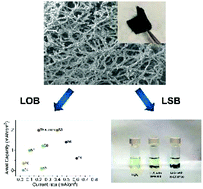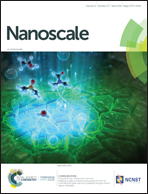Nitrogen-doped graphene fiber webs for multi-battery energy storage†
Abstract
Freestanding carbon-based electrodes with large surface areas and pore volumes are essential to fast ion transport and long-term energy storage. Many of the current porous carbon substrates are composed of particulates, making it difficult to form a self-supported structure. Herein, novel highly porous nitrogen-doped graphene fiber webs (N-GFWs) are prepared using a facile wet-spinning method. The wet chemical process facilitates simultaneous N-doping and surface wrinkling of graphene fibers in a one-pot process. The atomic structure and electrical conductivity of N-GFWs are tailored by tuning the degree of N-doping and thermal reduction for multi-battery charge storage in both lithium–oxygen batteries (LOBs) and lithium–sulfur batteries (LSBs). The N-GFW900 electrode presents an excellent electrocatalytic activity and the cathode with a high areal loading of 7.5 mg cm−2 delivers a remarkable areal capacity of 2 mA h cm−2 at 0.2 mA cm−2 for LOBs. The N-GFW700 interlayer with abundant oxygenated and nitrogen functional groups demonstrates effective entrapment of polysulfides in LSBs, delivering a much improved specific capacity after 200 cycles at 0.5C with a remarkable decay rate of 0.04%. The current approach paves the way for rational design of porous graphene-based electrodes, satisfying multifunctional requirements for high-energy storage applications.



 Please wait while we load your content...
Please wait while we load your content...